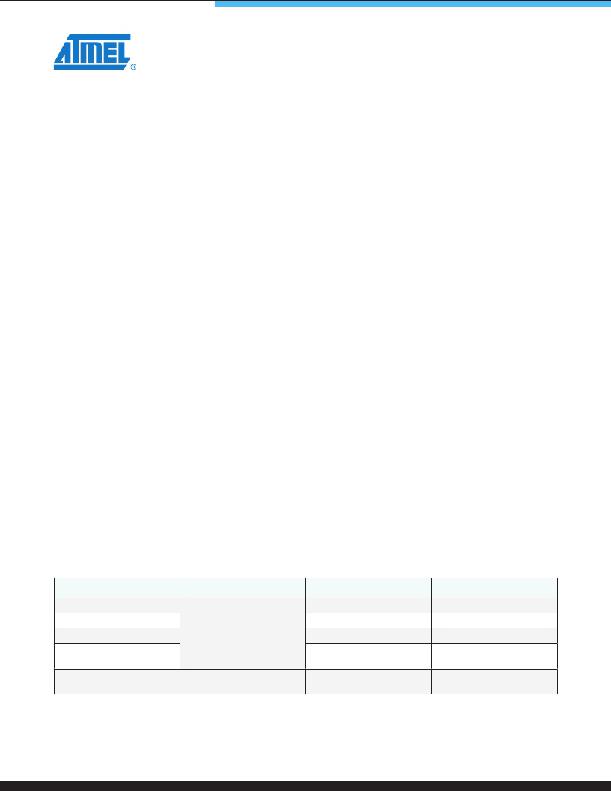- 您现在的位置:买卖IC网 > Sheet目录344 > MSL3082CS (Atmel)IC LED DRIVER 8 STRING

Quick Start Guide
The MSL3082 controls eight strings of series-connected
LEDs at up to at least 500mA per string, and up to
sixteen devices may share the serial interface. The
MSL3082 FET gate drive output is optimized for FETs
requiring no more than 10nC of charge. The MSL3082
PWM engine generates the PWM signal that drives the
strings, or optionally accepts an external PWM signal.
How Many LEDs and Drivers?
The MSL3082 drives eight strings of series-connected
LEDs using external N-channel MOSFETs and current
sense resistors. The LED drive capability (maximum
number of LEDs per string) is limited only by the
MOSFETs and the LED string power supply, not by
the MSL3082. Up to 16 MSL3082s may share an I 2 C/
SMBus serial interface, with both individual and broadcast
(all MSL3082s on a bus) addressing. The high LED drive
power of the MSL3082 makes it suitable for large LCD
TV and monitor backlights, as well as for LED signage
and general lighting.
LEDs, the String Power Supply, and
the Efficiency Optimizer
The MSL3082 features an Efficiency Optimizer output
that dynamically adjusts the LED string power supply to
the minimum voltage necessary to drive the LED strings,
minimizing power use while assuring accurate LED
current flow. The Efficiency Optimizers features an input
that allows up to eight devices to be connected in a chain
configuration. When implemented, the chain automatically
negotiates, controls, and optimizes the string power
The power supply can use any topology that employs
external feedback resistors with a maximum feedback
voltage of 1.5V, and are typically DC-DC boost
converters. The efficiency optimizers rely on close
matching of the LEDs connected to a string supply; the
better the matching, the better the overall efficiency.
Differences between Atmel LED
Drivers-MSL3082 and MSL2100
The MSL3082 includes a single Efficiency Optimizer,
is more suited for single-color LEDs, and is ideal for
driving white backlight LEDs in an LCD monitor or TV
application. The MSL2100 includes three independent
Efficiency Optimizer circuits to control three separate
string supplies (for RGB LEDs, for example).
Timing, PWM, Intensity Controls,
and Synchronization
The PWM LED drive signals synchronize to video frame
timing via the PHI input, and to pixel timing via the
GSC input. Suitability for LED backlight architectures is
shown in Table 1 and Table 2. Area LED dimming for
direct backlighting is supported for contrast and color
gamut improvement. With area dimming, motion blur is
reduced by setting each LED string’s PWM phasing to
synchronize string off times with the LCD update timing.
Also, the individual PWM intensity registers for eight
LED strings are updated with only 92 I 2 C/SMBus clocks.
Sixteen drivers (128 LED strings) update in 1.47ms
with a 1MHz bus speed, offering area dimming support
for frame rates up to 640Hz.
supply for all LED strings driven by the chain.
Table 1. Atmel LED Driver-MSL3082 LED Common Backlight Drive Architectures
4
BACKLIGHT TYPE
White LED - bottom edge-lit
White LED - top/bottom edge-lit
White LED - four sides edge-lit
White LED - direct back-lit
RGB LED - direct back-lit
STRING SUPPLY OPTIONS
1 or more MSL3082 per
efficiency optimized supply
See MSL2100 datasheet
MOTION BLUR REMOVAL
No
No
No
Yes - LED strip phasing
Yes - LED strip phasing
LED ZONE MANAGEMENT
No
No
No
Higher contrast ratio
(area dimming)
Higher contrast ratio and
color gamut
Atmel LED Driver-MSL3082
发布紧急采购,3分钟左右您将得到回复。
相关PDF资料
MSL3085BT
IC LED DRIVER 8 STRING
MSL3162BT
IC LED DRIVER 16 STRING
MSL3164BT
IC LED DRIVER 16 STRING
MSL3167GU
IC LED DRIVER 16 STRING
MT-6 PLUS
SURGE SUPPR TCHMSTR 6OUT 10'CORD
MT42L256M32D4KP-3 IT:A
IC LPDDR2 SDRAM 8GBIT 168FBGA
MT45W1MW16BDGB-708 AT
IC PSRAM 16MBIT 104MHZ 54VFBGA
MT48H32M16LFB4-75B IT:C
IC SDRAM 512MB 54VFBGA
相关代理商/技术参数
MSL3082CS-R
功能描述:LED照明驱动器 8Str Hi Pwr White or RGB LED Drivers
RoHS:否 制造商:STMicroelectronics 输入电压:11.5 V to 23 V 工作频率: 最大电源电流:1.7 mA 输出电流: 最大工作温度: 安装风格:SMD/SMT 封装 / 箱体:SO-16N
MSL3085
制造商:ATMEL 制造商全称:ATMEL Corporation 功能描述:8-string White and RGB LED Driver with Adaptive Power Control, EEPROM, and I2C/SMBus Serial Interface
MSL3085BT
功能描述:LED照明驱动器 8-Stinge White & RGB LED Dvrs wAdapt Pwr
RoHS:否 制造商:STMicroelectronics 输入电压:11.5 V to 23 V 工作频率: 最大电源电流:1.7 mA 输出电流: 最大工作温度: 安装风格:SMD/SMT 封装 / 箱体:SO-16N
MSL3085BT-R
功能描述:LED照明驱动器 8-String White & RGB LED Drivers with Ad
RoHS:否 制造商:STMicroelectronics 输入电压:11.5 V to 23 V 工作频率: 最大电源电流:1.7 mA 输出电流: 最大工作温度: 安装风格:SMD/SMT 封装 / 箱体:SO-16N
MSL3086-IU
功能描述:LED照明驱动器 8-Str LED Driver Internal Boost Cntr
RoHS:否 制造商:STMicroelectronics 输入电压:11.5 V to 23 V 工作频率: 最大电源电流:1.7 mA 输出电流: 最大工作温度: 安装风格:SMD/SMT 封装 / 箱体:SO-16N
MSL3086-IUR
功能描述:LED照明驱动器 8-Str LED Driver Internal Boost Cntr
RoHS:否 制造商:STMicroelectronics 输入电压:11.5 V to 23 V 工作频率: 最大电源电流:1.7 mA 输出电流: 最大工作温度: 安装风格:SMD/SMT 封装 / 箱体:SO-16N
MSL3088-IU
功能描述:LED照明驱动器 8-Str LED Driver Intrnl Bst Cntr/Phas
RoHS:否 制造商:STMicroelectronics 输入电压:11.5 V to 23 V 工作频率: 最大电源电流:1.7 mA 输出电流: 最大工作温度: 安装风格:SMD/SMT 封装 / 箱体:SO-16N
MSL3088-IUR
功能描述:LED照明驱动器 8-Str LED Driver Intrnl Bst Cntr/Phas
RoHS:否 制造商:STMicroelectronics 输入电压:11.5 V to 23 V 工作频率: 最大电源电流:1.7 mA 输出电流: 最大工作温度: 安装风格:SMD/SMT 封装 / 箱体:SO-16N
